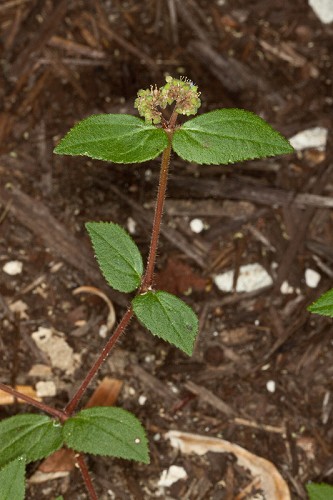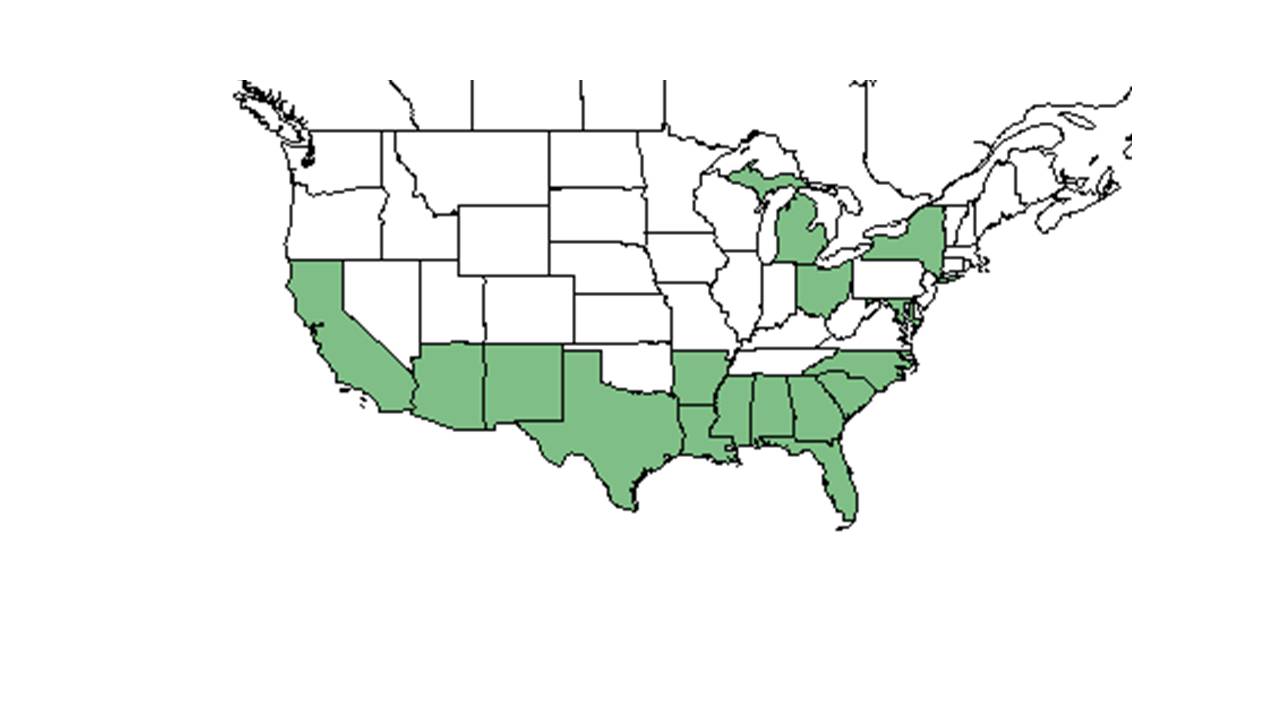Difference between revisions of "Euphorbia hirta"
KatieMccoy (talk | contribs) |
HaleighJoM (talk | contribs) (→Ecology) |
||
| (15 intermediate revisions by 7 users not shown) | |||
| Line 3: | Line 3: | ||
{{taxobox | {{taxobox | ||
| name = Euphorbia hirta | | name = Euphorbia hirta | ||
| − | | image = | + | | image = Euph_hirt.jpg |
| − | | image_caption = | + | | image_caption = Photo by John R. Gwaltney, [http://www.southeasternflora.com/index.asp Southeastern Flora.com] |
| regnum = Plantae | | regnum = Plantae | ||
| divisio = Magnoliophyta - Flowering plants | | divisio = Magnoliophyta - Flowering plants | ||
| Line 18: | Line 18: | ||
}} | }} | ||
| − | Common name: | + | Common name: Pillpod sandmat |
| + | ==Taxonomic notes== | ||
| + | Synonyms: ''Chamaesyce hirta'' (Linnaeus) Millspaugh.<ref name="weakley">Weakley, A.S. 2015. Flora of the southern and mid-atlantic states. Working Draft of 21 May 2015. University of North Carolina at Chapel Hill, Chapel Hill, North Carolina.</ref> | ||
| + | |||
| + | Varieties: none.<ref name="weakley">Weakley, A.S. 2015. Flora of the southern and mid-atlantic states. Working Draft of 21 May 2015. University of North Carolina at Chapel Hill, Chapel Hill, North Carolina.</ref> | ||
| − | |||
| − | |||
==Description== | ==Description== | ||
<!-- Basic life history facts such as annual/perrenial, monoecious/dioecious, root morphology, seed type, etc. --> | <!-- Basic life history facts such as annual/perrenial, monoecious/dioecious, root morphology, seed type, etc. --> | ||
==Distribution== | ==Distribution== | ||
| + | This species is found from eastern North Carolina to central South Carolina, as far south as southern Florida, and as far west as Texas. It also occurs in Central and South America.<ref name="weakley">Weakley, A.S. 2015. Flora of the southern and mid-atlantic states. Working Draft of 21 May 2015. University of North Carolina at Chapel Hill, Chapel Hill, North Carolina.</ref> | ||
| + | |||
==Ecology== | ==Ecology== | ||
===Habitat=== <!--Natural communities, human disturbed habitats, topography, hydrology, soils, light, fire regime requirements for removal of competition, etc.--> | ===Habitat=== <!--Natural communities, human disturbed habitats, topography, hydrology, soils, light, fire regime requirements for removal of competition, etc.--> | ||
| − | It has been observed to grow in disturbed areas such as lawns, gardens, roadside depressions, vacant lots, fallow fields, and parking lots | + | It has been observed to grow in disturbed areas such as lawns, gardens, roadside depressions, vacant lots, fallow fields, and parking lots. It can grow in dry sands and silty loam on mesic areas as well.<ref name=fsu>Florida State University Robert K. Godfrey Herbarium database. URL: http://herbarium.bio.fsu.edu. Last accessed: June 2014. Collectors: L. C. Anderson, W. R. Anderson, A. Clewell, K. Blum, M. R. Crosby, J. Duke, J. Dwyer, S. F. da Fonseca, R. K. Godfrey, H. A. Hespenheide, H. S. Irwin, R. Komarek, R. L. Lazor, H. Loftin, T. MacClendon, K. MacClendon, E. Onishi, J. Ramos, R. Reis dos Santos, T. R. Soderstrom, R. Souza, and E. L. Tyson. States and Counties: Florida: Calhoun, Franklin, Jackson, Leon, Liberty, and Wakulla. Georgia: Thomas. Other countries: Brazil, Honduras, Panama, Costa Rica, and Jamaica.</ref> |
===Phenology=== <!--Timing off flowering, fruiting, seed dispersal, and environmental triggers. Cite PanFlora website if appropriate: http://www.gilnelson.com/PanFlora/ --> | ===Phenology=== <!--Timing off flowering, fruiting, seed dispersal, and environmental triggers. Cite PanFlora website if appropriate: http://www.gilnelson.com/PanFlora/ --> | ||
| − | This species has been observed to flower and fruit from July to August | + | This species has been observed to flower and fruit from July to August. <ref name="FSU Herbarium">Florida State University Robert K. Godfrey Herbarium database. URL: [http://herbarium.bio.fsu.edu http://herbarium.bio.fsu.edu]. Last accessed: June 2014. Collectors: L. C. Anderson, W. R. Anderson, A. Clewell, K. Blum, M. R. Crosby, J. Duke, J. Dwyer, S. F. da Fonseca, R. K. Godfrey, H. A. Hespenheide, H. S. Irwin, R. Komarek, R. L. Lazor, H. Loftin, T. MacClendon, K. MacClendon, E. Onishi, J. Ramos, R. Reis dos Santos, T. R. Soderstrom, R. Souza, and E. L. Tyson. States and Counties: Florida: Calhoun, Franklin, Jackson, Leon, Liberty, and Wakulla. Georgia: Thomas. Other countries: Brazil, Honduras, Panama, Costa Rica, and Jamaica.</ref> |
| + | <!--===Seed dispersal===--> | ||
| + | <!--===Seed bank and germination===--> | ||
| + | <!--===Fire ecology===--> <!--Fire tolerance, fire dependence, adaptive fire responses--> | ||
| + | <!--===Pollination===--> | ||
| + | <!--===Herbivory and toxicology===--> | ||
| + | <!--===Diseases and parasites===--> | ||
| + | |||
| + | ==Conservation, cultivation, and restoration== | ||
| + | |||
| + | ==Cultural use== | ||
| + | Members of this genus can be used as a laxative in small amounts, but an overdose can cause severe poisoning.<ref> Mueschner, W.C. 1957. Poisonous Plants of the United States. The Macmillan Company, New York.</ref> | ||
| − | |||
| − | |||
| − | |||
| − | |||
| − | |||
| − | |||
| − | |||
| − | |||
==Photo Gallery== | ==Photo Gallery== | ||
| + | <gallery widths=180px> | ||
| + | </gallery> | ||
| + | |||
==References and notes== | ==References and notes== | ||
| − | |||
Latest revision as of 19:42, 30 June 2022
| Euphorbia hirta | |
|---|---|

| |
| Photo by John R. Gwaltney, Southeastern Flora.com | |
| Scientific classification | |
| Kingdom: | Plantae |
| Division: | Magnoliophyta - Flowering plants |
| Class: | Magnoliopsida – Dicotyledons |
| Order: | Euphorbiales |
| Family: | Euphorbiaceae |
| Genus: | Euphorbia |
| Species: | E. hirta |
| Binomial name | |
| Euphorbia hirta (L.) Millsp. | |

| |
| Natural range of Euphorbia hirta from USDA NRCS Plants Database. | |
Common name: Pillpod sandmat
Contents
Taxonomic notes
Synonyms: Chamaesyce hirta (Linnaeus) Millspaugh.[1]
Varieties: none.[1]
Description
Distribution
This species is found from eastern North Carolina to central South Carolina, as far south as southern Florida, and as far west as Texas. It also occurs in Central and South America.[1]
Ecology
Habitat
It has been observed to grow in disturbed areas such as lawns, gardens, roadside depressions, vacant lots, fallow fields, and parking lots. It can grow in dry sands and silty loam on mesic areas as well.[2]
Phenology
This species has been observed to flower and fruit from July to August. [3]
Conservation, cultivation, and restoration
Cultural use
Members of this genus can be used as a laxative in small amounts, but an overdose can cause severe poisoning.[4]
Photo Gallery
References and notes
- ↑ 1.0 1.1 1.2 Weakley, A.S. 2015. Flora of the southern and mid-atlantic states. Working Draft of 21 May 2015. University of North Carolina at Chapel Hill, Chapel Hill, North Carolina.
- ↑ Florida State University Robert K. Godfrey Herbarium database. URL: http://herbarium.bio.fsu.edu. Last accessed: June 2014. Collectors: L. C. Anderson, W. R. Anderson, A. Clewell, K. Blum, M. R. Crosby, J. Duke, J. Dwyer, S. F. da Fonseca, R. K. Godfrey, H. A. Hespenheide, H. S. Irwin, R. Komarek, R. L. Lazor, H. Loftin, T. MacClendon, K. MacClendon, E. Onishi, J. Ramos, R. Reis dos Santos, T. R. Soderstrom, R. Souza, and E. L. Tyson. States and Counties: Florida: Calhoun, Franklin, Jackson, Leon, Liberty, and Wakulla. Georgia: Thomas. Other countries: Brazil, Honduras, Panama, Costa Rica, and Jamaica.
- ↑ Florida State University Robert K. Godfrey Herbarium database. URL: http://herbarium.bio.fsu.edu. Last accessed: June 2014. Collectors: L. C. Anderson, W. R. Anderson, A. Clewell, K. Blum, M. R. Crosby, J. Duke, J. Dwyer, S. F. da Fonseca, R. K. Godfrey, H. A. Hespenheide, H. S. Irwin, R. Komarek, R. L. Lazor, H. Loftin, T. MacClendon, K. MacClendon, E. Onishi, J. Ramos, R. Reis dos Santos, T. R. Soderstrom, R. Souza, and E. L. Tyson. States and Counties: Florida: Calhoun, Franklin, Jackson, Leon, Liberty, and Wakulla. Georgia: Thomas. Other countries: Brazil, Honduras, Panama, Costa Rica, and Jamaica.
- ↑ Mueschner, W.C. 1957. Poisonous Plants of the United States. The Macmillan Company, New York.